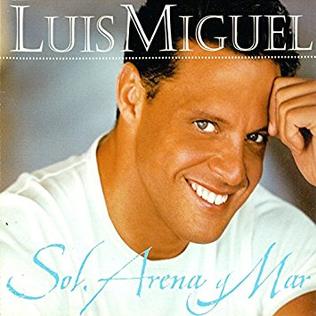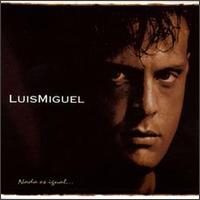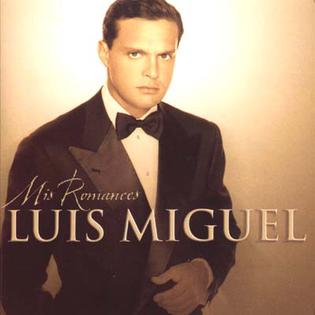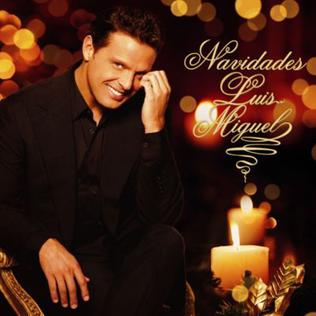
Juan Luis Guerra Seijas is a Dominican musician, singer, composer, and record producer. He has sold 15 million records worldwide, making him one of the best-selling Latin music artists. Throughout his career, he has won numerous awards including 24 Latin Grammy Awards, three Grammy Awards, and one Latin Billboard Music Award. He won 3 Latin Grammy Awards in 2010, including Album of the Year. In 2012, he won the Latin Grammy Award for Producer of the Year.

Mexican recording artist Luis Miguel has released 21 studio albums, 30 compilation albums, three extended plays (EP) two live albums, two soundtrack albums and five box set. Luis Miguel has sold over 60 million records, making him one of the best-selling Latin music artists of all time. Luis Miguel is also the artist with the second-most number ones on the Billboard Top Latin Albums chart with nine albums. At the age of 11, he released his debut studio album, Un Sol (1982), which was certified platinum and gold in Mexico. The artist would release four more studio albums under the record label EMI: Directo al Corazón (1982), Decídete (1983), También es Rock (1984), and Palabra de Honor (1984). A Portuguese-language version of Decídete and Palabra de Honor were released in Brazil as Decide Amor and Meu Sonho Perdido, respectively. Luis Miguel made his acting debut in the film as the lead role on Ya nunca más (1984) and recorded its soundtrack. In 1985, he participated in the Sanremo Music Festival 1985 with the song "Noi ragazzi di oggi"; it placed second in the Big Artist category and was later included on the Italian-language edition of Palabra de Honor. In the same year, Luis Miguel recorded the soundtrack for the film Fiebre de amor, which he co-starred with fellow Mexican singer Lucero.

Romances is the twelfth studio album by Mexican singer Luis Miguel, released on 12 August 1997, by WEA Latina. It is the third album of the Romance series, in which Miguel covers Latin songs from 1940 to 1978. Aside from Miguel, the production also involved arranger Bebu Silvetti, and Armando Manzanero, who directed all of Miguel's Romance albums. Romances consists of twelve cover versions and two new compositions by Manzanero and Silvetti. Recording took place in early 1997 at the Ocean Way recording studio in Los Angeles, California.

Romance is the eighth studio album by Mexican singer Luis Miguel. It was released by WEA Latina on 19 November 1991. Although the production was originally intended as another collaboration with Juan Carlos Calderón, that plan was scrapped when Calderón was unable to compose songs for the album. Facing a new-material deadline in his recording contract, at his manager's suggestion Miguel chose bolero music for his next project. Mexican singer-songwriter Armando Manzanero was hired by WEA Latina to co-produce the album with Miguel. Recording began in August 1991 at Ocean Way Recording in Hollywood, California, with Bebu Silvetti the arranger.

Segundo Romance is the tenth studio album by Mexican singer Luis Miguel, released on 30 August 1994 through WEA Latina. Like Miguel's 1991 album Romance, Segundo Romance comprises cover versions of boleros written between 1934 and 1993. It was produced by Miguel with Juan Carlos Calderón, Kiko Cibrian and Armando Manzanero and recorded in early 1994 at the Record Plant in Los Angeles.

Amarte Es un Placer is the thirteenth studio album by Mexican singer Luis Miguel. It was released by WEA Latina on 13 September 1999. Produced by Miguel, it is a pop album with R&B and jazz influences. Miguel was more involved with the songwriting on this record than on earlier albums and was assisted by composers including Arturo Pérez, Armando Manzanero, and Juan Carlos Calderón. Despite the popularity of his contemporaries Ricky Martin and Enrique Iglesias who crossed over to the English-language market, Miguel preferred to sing and record in Spanish at the time.

"Sol, Arena y Mar" is a song written by Arturo Perez, Francisco Loyo, and Salo Loyo and co-written, produced, and performed by Mexican singer Luis Miguel. It is a horn-driven uptempo pop song with jazz influence which deals with a strained relationship. The song's lyrics were rumored to have been influenced by Miguel's previous relationship with Daisy Fuentes. It was released as the lead single from the album Amarte Es un Placer on 19 July 1999.

"Dormir Contigo" is a song written by Armando Manzanero and produced and performed by Mexican singer Luis Miguel. The song is a pop ballad in which the protagonist expresses the joy of sleeping with his partner. It was released as the third single from the album Amarte Es un Placer in January 2000. The track peaked at number 11 Billboard Hot Latin Songs chart in the United States and number two on the Latin Pop Songs chart.

Nada Es Igual is the eleventh studio album by Mexican recording artist Luis Miguel. It was released by WEA Latina on 20 August 1996. The album has a musical style similar to his previous pop album Aries (1993) on which Miguel performs power ballads and R&B tunes. Recording took place at the Record Plant Studios in February 1996, with production handled by Miguel and his longtime associate Kiko Cibrian. Its songwriting was assisted by Cibrian, Rudy Pérez, and Alejandro Lerner. The album was promoted by three singles: "Dame", "Cómo Es Posible Que a Mi Lado", and "Que Tú Te Vas"; the former became the most successful single reaching number two and number one on the Billboard Hot Latin Songs and Latin Pop Songs charts, respectively. To further promote the recording, Miguel launched the Tour America 1996 where he performed in several South American countries.

Mis Romances is the fourteenth studio album of Mexican singer Luis Miguel, released on 20 November 2001 by Warner Music Latina. It is the fourth album in the Romance series wherein Luis Miguel covers bolero standards from Latin America and includes two original compositions. Produced by Luis Miguel, the album was recorded at the Record Plant in Los Angeles, California with the participation of the Royal Philharmonic Orchestra at the Abbey Road Studios in London, England. The recording was promoted by three singles: "Amor, Amor, Amor", "Cómo Duele", and "Al Que Me Siga". It was further promoted by a tour in 2002 that had Luis Miguel performing in the United States, Latin America, and Spain. It was the highest-grossing tour of the year by a Latin artist in the U.S.

México en la Piel is the sixteenth studio album by Mexican singer Luis Miguel. Released on 9 November 2004 by Warner Music Latina, it is Miguel's first mariachi album. The record contains thirteen mariachi covers, accompanied by the Vargas de Tecalitlán folk ensemble. Armando Manzanero was its musical director, and Miguel its producer. The album was recorded at Ocean Way Recording in Hollywood, California in July 2004. A special edition, México en la Piel: Edición Diamante, was released on 5 September 2005 with two additional songs and a DVD with five music videos. Four singles were released from the album: "El Viajero", "Que Seas Feliz", "Sabes una Cosa", and "Échame a Mí la Culpa". "Mi Ciudad" was released as a single from the special edition.

33 is the fifteenth studio album by Mexican singer Luis Miguel. It was released through Warner Music Latina on 30 September 2003. It is a pop record which contains pop ballads and uptempo disco numbers. The album was produced by Miguel and recorded in Hollywood, California. 33 was promoted by two singles: "Te Necesito" and "Un Te Amo". It was also promoted by a tour which lasted from 2003 to 2004. Several songwriters including Armando Manzanero, Juan Luis Guerra, and Kike Santander contributed to the compositions in the record.

América & en Vivo is a live extended play (EP) by Mexican singer Luis Miguel. It was released on 25 September 1992 by WEA Latina. The EP consists of three live versions of "Inolvidable", No Sé Tú", and "Contigo en la Distancia" from his performance at the National Auditorium in Mexico during his Romance Tour on June 26, 1992, as well as a new track "America, America", originally performed by Nino Bravo. "America, America" was released as a single and peaked at number 20 on the Billboard Hot Latin Songs chart. The EP was rated three out of five stars by an editor on AllMusic and received a positive review from Mario Taradell of the Miami Herald, who praised his vocals and the production of the EP. América & En Vivo peaked at number 12 on the Billboard Latin Pop Albums chart and was certified platinum in Argentina by the Argentine Chamber of Phonograms and Videograms Producers (CAPIF).

Navidades (transl. Christmas) is the 17th studio album by Mexican singer Luis Miguel, which Warner Music Latina released on 14 November 2006. It is Miguel's first Christmas album, and features Spanish-language adaptations of English-language songs and carols consisting of big band numbers and string-laden ballads. Édgar Cortázar and Juan Carlos Calderón adapted the songs and Miguel produced the album. To promote Navidades, "Mi Humilde Oración" and "Santa Claus Llegó a la Ciudad" were simultaneously released as lead singles, and Luis Miguel performed two tracks from the album on the set list on the third leg of his México En La Piel Tour (2005–07) in November and December 2006.

Vivo is the third live album by Mexican singer Luis Miguel. It was filmed at the Auditorio Coca-Cola concert hall in Monterrey, Mexico, where Miguel performed from 13 to 17 April 2000, as part of the second leg of his Amarte Es Un Placer Tour. Vivo was released in a live audio CD, DVD and VHS format. Vivo is the first Spanish-language live album to be released on NTSC, PAL, and DVD formats. The audio version was produced by Miguel while David Mallet directed the video album. The audio disc was released on 3 October 2000, while the video album was released on 24 October. Miguel's renditions of "Y" and "La Bikina", which he specifically performed during the concert shows in Mexico where he was joined by Cutberto Pérez's band Mariachi 2000, made available as singles for the album.

Cómplices (transl. Accomplices) is the 18th studio album by Mexican singer Luis Miguel, released on 2 May 2008 by Warner Music Latina. The record is a collaboration with Spanish musician Manuel Alejandro, who wrote and arranged the songs, and co-produced the album with Luis Miguel. Musically, it is a pop album of mostly ballads and a few uptempo tracks with lyrics emphasizing romance. Two singles were released to promote the album: "Si Tú Te Atreves" and "Te Desean". To further promote the record, Luis Miguel embarked on the year-long Cómplices Tour from September 2008 to September 2009. He performed in North America and a few countries in South America.

The Amarte Es Un Placer Tour was a concert tour by Luis Miguel to promote his album Amarte Es Un Placer. This tour had a length of 8 months and ran through Mexico, US, Argentina, Chile, Uruguay, Venezuela, Brazil and Spain between 1999 and 2000. It was the highest-grossing tour ever made by a Spanish-speaking artist, as well as the most extended. The tour consisted of 99 concerts, and was attended by approximately 1.5 million fans. These two records have been broken by another tour of the same artist, the Mexico En La Piel Tour.

Cómplices Tour was a concert tour by the Mexican singer Luis Miguel to promote his album Cómplices. The tour consisted of 91 concerts and ran through, US, Canada, Dominican Republic, Puerto Rico, Chile, Argentina, Uruguay and Mexico between 2008 and 2009, grossing $36.1 million from 73 shows reported with 450,000 spectators.
"Inolvidable" ("Unforgettable") is a song written by Julio Gutiérrez in 1944. It is considered one of the most popular boleros released during the Cuban musical movement led by pianists. The song has been recorded by several performers, including Roberto Carlos, Diego El Cigala, Fania All-Stars, Eydie Gormé, Danny Rivera, Tito Rodríguez and Bebo Valdés, among others.























